check engine BUICK CENTURY 1994 Owner's Manual
[x] Cancel search | Manufacturer: BUICK, Model Year: 1994, Model line: CENTURY, Model: BUICK CENTURY 1994Pages: 308, PDF Size: 16.3 MB
Page 225 of 308
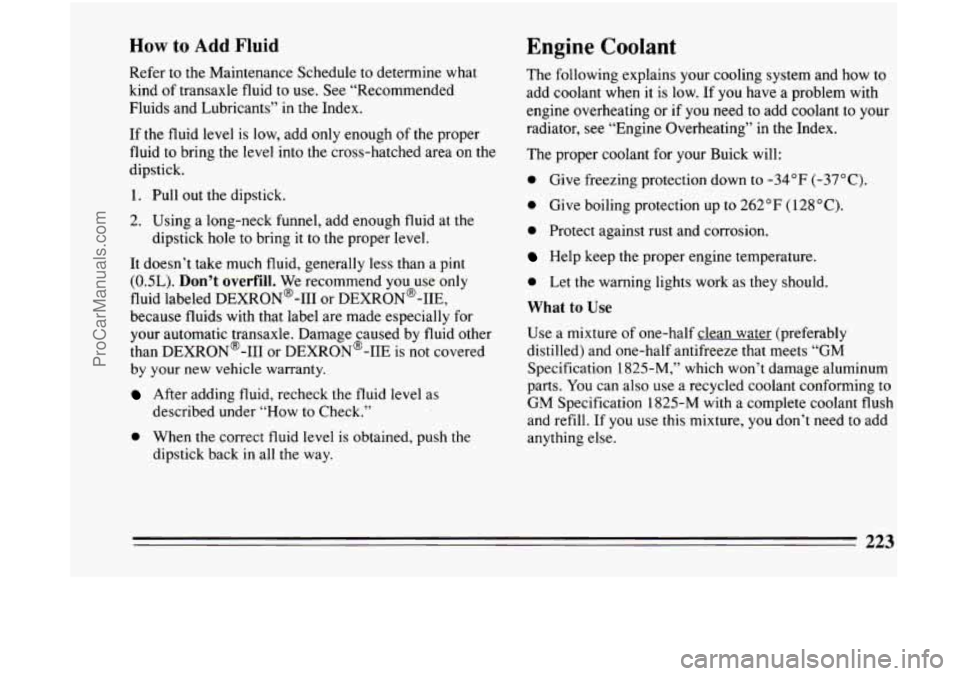
How to Add Fluid
Refer to the Maintenance Schedule to determine what
kind of transaxle fluid
to use. See “Recommended
Fluids and Lubricants” in the Index.
Engine Coolant
If the fluid level is low, add only enough of the proper
fluid to bring the level into the cross-hatched area on the
dipstick.
1. Pull
out the dipstick.
2. Using a long-neck funnel, add enough fluid at the
It doesn’t take much fluid, generally less than a pint
(OSL).
Don’t overfill. We recommend you use only
fluid labeled DEXRON@-I11 or DEXRON@-IIE,
because fluids with that label are made especially for
your automatic transaxle. Damage caused by fluid other
than DEXRON@-I11 or DEXRON@-IIE is
not covered
by your new vehicle warranty. dipstick
hole
to bring it to the proper level.
After adding fluid, recheck the fluid level as
described under “How to Check.”
0 When the correct fluid level is obtained, push the
dipstick back in all the way. The following explains
your cooling system and how to
add coolant when it is low. If you have a problem with
engine overheating or if
you need to add coolant to your
radiator, see “Engine Overheating” in the Index.
The proper coolant for your Buick will:
0 Give freezing protection down to -34°F (-37°C).
0 Give boiling protection up to 262 “F ( 128 “C).
0 Protect against rust and corrosion.
Help keep the proper engine temperature.
0 Let the warning lights work as they should.
What to Use
Use a mixture of one-half clean water (preferably
distilled) and one-half antifreeze that meets “GM
Specification 1825-M,” which won’t damage aluminum
parts.
You can also use a recycled coolant conforming to
GM Specification 1825-M with a complete coolant flush
and refill. If you use this mixture,
you don’t need to add
anything else.
223
ProCarManuals.com
Page 227 of 308
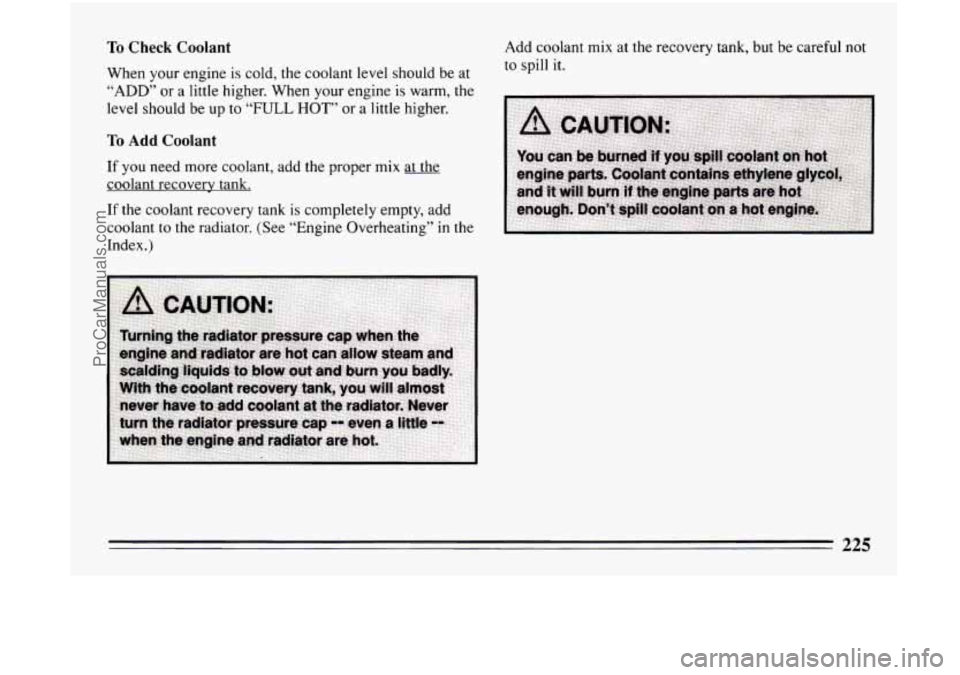
To Check Coolant
When your engine is cold, the coolant level should be at
“ADD” or a little higher. When your engine is warm, the
level should be up to
“FULL HOT’’ or a little higher.
To Add Coolant
If you need more coolant, add the proper mix at the
coolant recovery tank.
If the coolant recovery tank is completely empty, add
coolant to the radiator. (See “Engine Overheating” in the
Index.) Add
coolant mix at the recovery tank, but be careful not
to spill it.
225
ProCarManuals.com
Page 228 of 308

Radiator Pressure Cap
I NOTICE:
Your radiator cap is a 15 psi (105 kPa)
pressure-type cap and must be tightly installed
to prevent coolant
loss and possible engine
damage from overheating. Be sure the arrows on
the cap line up with the overflow tube on the radiator filler neck.
When you replace your radiator pressure cap, an AC@
cap is recommended.
Thermostat
Engine coolant temperature is controlled by a thermostat
in the engine coolant system. The thermostat stops the
flow
of coolant through the radiator until the coolant
reaches a preset temperature.
When
you replace your thermostat, an AC@ thermostat
is recommended.
Power Steering Fluid
The power steering fluid
reservoir
is located on the
passenger’s side
of the
engine compartment.
How To Check Power Steering Fluid
Unscrew the cap and wipe the dipstick with a clean rag.
Replace the cap and completely tighten it. Then remove
the cap again and look at the fluid level
on the dipstick.
0 When the engine compartment is hot, the level
should be at the
“H” (Hot) mark.
0 When the engine compartment is cool, the level
should be at the “C” (Cold) mark.
ProCarManuals.com
Page 264 of 308

IMPORTANT:
KEEP ENGINE OIL
AT THE PROPER
LEVEL
AND CHANGE AS
RECOMMENDED
I protection
Plan
Have you purchased the GM Protection Plan? The
Plan supplements
your new vehicle warranties. See
your Buick dealer
for details.
Introduction
A Word About Maintenance
We at General Motors want to help you keep your
vehicle in good working condition. But we don’t know
exactly how you’ll drive it.
You may drive very short
distances only a few times a week. Or you may drive
long distances all the time in very hot, dusty weather.
You may use your vehicle in making deliveries. Or you
may drive it to work, to do errands
or in many other
ways.
Because of all the different ways people use their GM
vehicles, maintenance needs vary.
You may even need
more frequent checks and replacements
than you will
find in the schedules in this part.
So please read this
part and note how you drive.
If you have any questions
on
how to keep your vehicle in good condition, see your
Buick dealer, the place many GM owners choose to
have their maintenance work done.
Your dealer can be
relied upon to use proper parts and practices.
262
ProCarManuals.com
Page 272 of 308
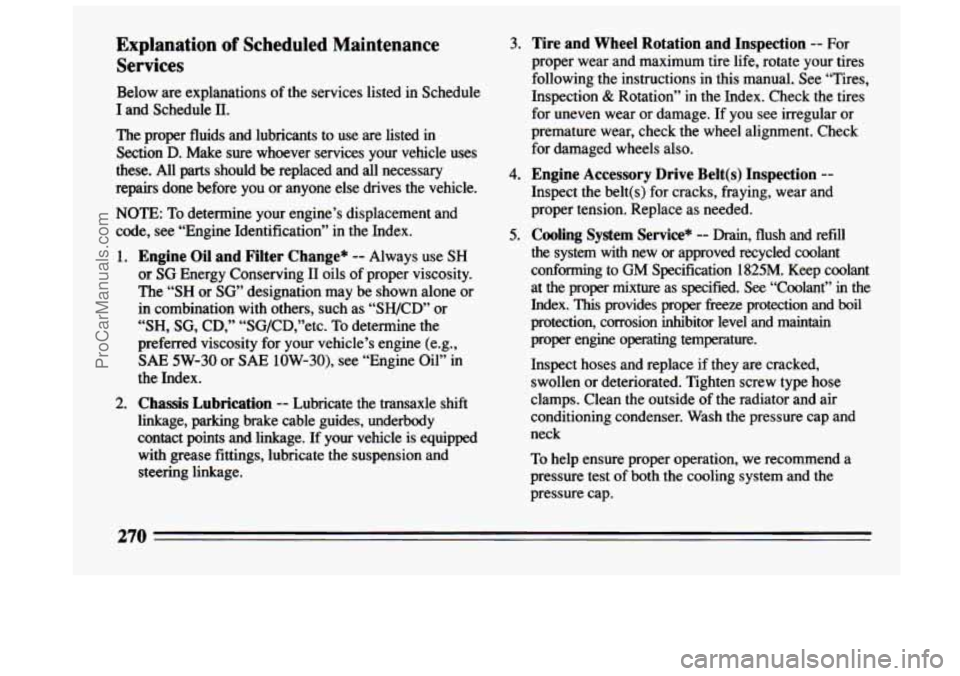
Explanation of Scheduled Maintenance
Services
Below are explanations of the services listed in Schedule
I and Schedule
11.
The proper fluids and lubricants to use are listed in
Section D. Make sure whoever services your vehicle uses
these. All parts should
be replaced and all necessary
repairs done before you or anyone else drives the vehicle.
NOTE: To determine your engine’s displacement and
code, see “Engine Identification” in the Index.
1. Engine Oil and Filter Change* -- Always use SH
or SG Energy Conserving I1 oils of proper viscosity.
The
“SH or SG’ designation may be shown alone or
in combination with others, such as “SH/CD’ or
“SH, SG, CD,” “SG/CD,”etc. To determine the
preferred viscosity for your vehicle’s engine (e.g.,
SAE 5W-30 or SAE 10W-30), see “Engine Oil” in
the Index.
2. Chassis Lubrication -- Lubricate the transaxle shift
linkage, parking brake cable guides, underbody
contact points and linkage. If your vehicle is equipped with grease fittings, lubricate the suspension and steering linkage. 3.
Tire and Wheel Rotation and Inspection -- For
proper wear and maximum tire life, rotate your tires
following the instructions in this manual. See “Tires,
Inspection
& Rotation” in the Index. Check the tires
for uneven wear or damage. If you see irregular or
premature wear, check the wheel alignment. Check
for damaged wheels also.
4. Engine Accessory Drive Belt(s) Inspection --
Inspect the belt(s) for cracks, fraying, wear and
proper tension. Replace as needed.
5. Cooling System Service* -- Drain, flush and refill
the system with new or approved recycled coolant
conforming to GM Specification 1825M. Keep coolant
at the proper mixture as specified.
See “Coolant” in the
Index.
This provides proper freeze protection and boil
protection, corrosion inhibitor level and maintain
proper engine operating temperature.
Inspect hoses and replace if they are cracked,
swollen or deteriorated. Tighten screw type hose
clamps. Clean the outside of the radiator and air
conditioning condenser. Wash the pressure cap and
neck
To help ensure proper operation, we recommend a
pressure test
of both the cooling system and the
pressure cap.
270
ProCarManuals.com
Page 273 of 308

6. ’Ikande Service -- Change both the fluid and filter
every 15,000 miles
(25 0oO km) if the vehicle is
mainly driven under one or more of these conditions:
In heavy city traffic where the outside
temperature regularly reaches
90°F (32 “C) or
higher.
0 In hilly or mountainous terrain.
0 When doing frequent trailer towing.
Uses such as found in taxi, police car or delivery
service.
9. Exhaust Gas Recirculation (EGR) System
Inspection
(2.2 L Code 4 engine only) *? ---
Conduct the EGR system service as described in the
service manual.
To purchase a service manual, see
“Service Publications” in the Index.
10. Air Cleaner Filter Replacement* -- Replace every
30,000 miles (50 0o0 km) or more often under dusty
conditions. Ask your dealer for the proper
replacement intervals for your driving conditions.
11.
Fuel Tank, Cap and Lines Inspection*? -- Inspect
fuel
tank, cap and lines for damage or leaks. Inspect
fuel cap gasket for an even filler neck imprint
or any
damage. Replace parts as needed. Periodic replacement
of the fuel filter is not required.
If you
do not use your vehicle under any of these
conditions, change both the fluid and filter every 100,OOO miles (160 OOO km).
7. Spark Plug Replacement* -- Replace spark plugs
with the proper type. See “Specifications Chart”
in
the Index.
8. Spark Plug Wire Inspection*’f’ -- Inspect for bums,
cracks or other damage. Check the boot fit at the
distributor and at the spark plugs. Replace wires as
needed.
* An Emission Control Service.
The
U.S. Environmental Protection Agency or the California Air Resources Board has determined that the fail\
ure to perform this maintenance item will not nullify the
emission warranty or limit recall liability prior to the completion of vehicle useful life. General Motors, however, urges that all recommended maintenance services be performed at the indicated intervals and the maintenance be recorded in “Section E:Maintenance Record”.
271
ProCarManuals.com
Page 274 of 308
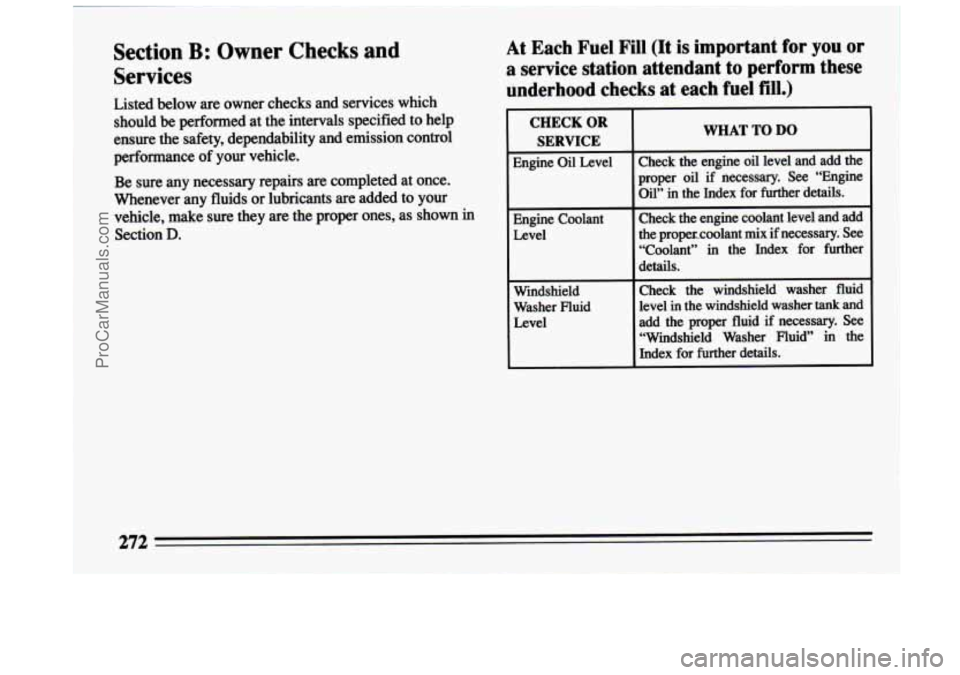
Section B: Owner Checks and
Services
Listed below are owner checks and services which should
be performed at the intervals specified to help
ensure the safety, dependability and emission control
performance of your vehicle.
Be sure any necessary repairs are completed at once.
Whenever any fluids
or lubricants are added to your
vehicle, make sure they are the proper ones, as shown in Section
D.
At Each Fuel Fill (It is important for you or
a service station attendant to perform these
underhood checks at each fuel fill.)
WHAT TO DO
~
Engine Oil Level
Engine Coolant Level
Windshield
Washer Fluid Level Check the engine oil level and add the
proper oil if necessary. See “Engine
Oil” in the Index for further details.
Check the engine coolant level and add
the propexcoolant mix if necessary. See “Coolant” in the Index for further
details.
Check the windshield washer fluid
level in the windshield washer
tank and
add the proper fluid if necessary. See “Windshield Washer Fluid” in the
Index for further details.
272
ProCarManuals.com
Page 275 of 308
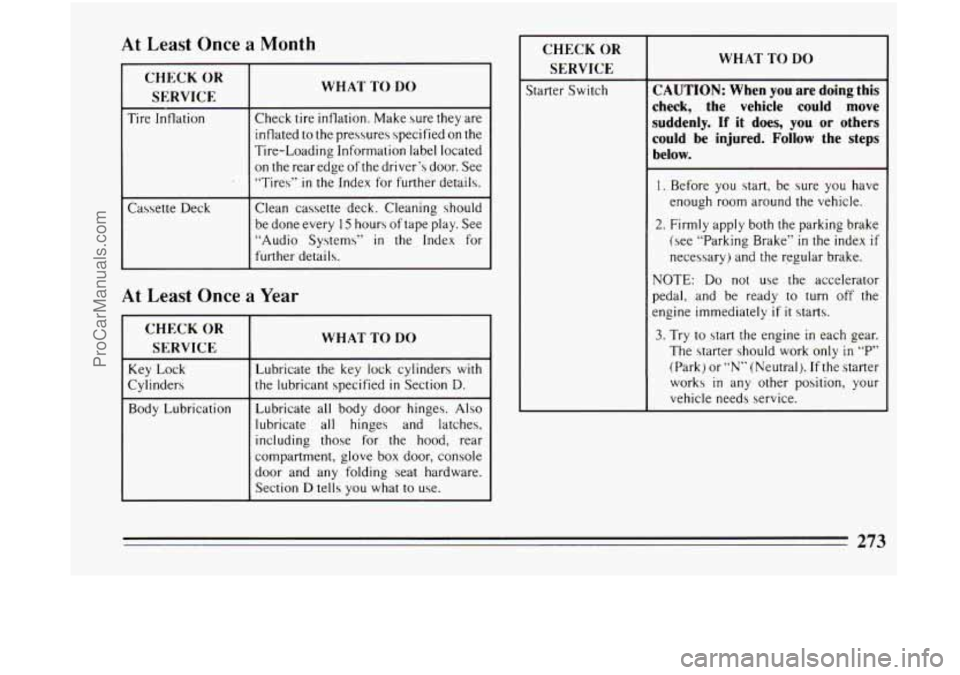
At Least Once a Month
WHAT TO DO
Check tire inflation. Make sure they are
inflated
to the pressures specified on the
Tire-Loading Information label located
on the rear edge of the driver’s door. See
“Tires”
in the Index for further details.
Cassette Deck Clean
cassette deck. Cleaning should
be done every
15 hours of tape play. See
“Audio Systems”
in the Index for
further details.
At Least Once a Year
CHECK OR
SERVICE
Key Lock
Cylinders
L
Body Lubrication
WHAT TO DO
Lubricate the key lock cylinders with
the lubricant specified in Section D.
Lubricate all body door hinges. Also
lubricate all hinges and latches,
including those for the hood, rear
compartment, glove box door, console
door and any folding seat hardware.
Section
D tells you what to use.
CHECK OR
SERVICE
Starter Switch
WHAT TO DO
CAUTION: When you are doing this
check, the
vehicle could move
suddenly. If it does, you or others
could
be injured. Follow the steps
below.
1. Before you start, be sure you have
enough room around the vehicle.
2. Firmly apply both the parking brake
(see “Parking Brake”
in the index if
necessary) and the regular brake.
NOTE: Do
not use the accelerator
pedal, and be ready
to turn off the
engine immediately
if it starts.
3. Try to start the engine in each gear.
The starter should work
only in “P”
(Park) or
“N” (Neutral). If the starter
works
in any other position, your
vehicle needs service.
273
ProCarManuals.com
Page 276 of 308
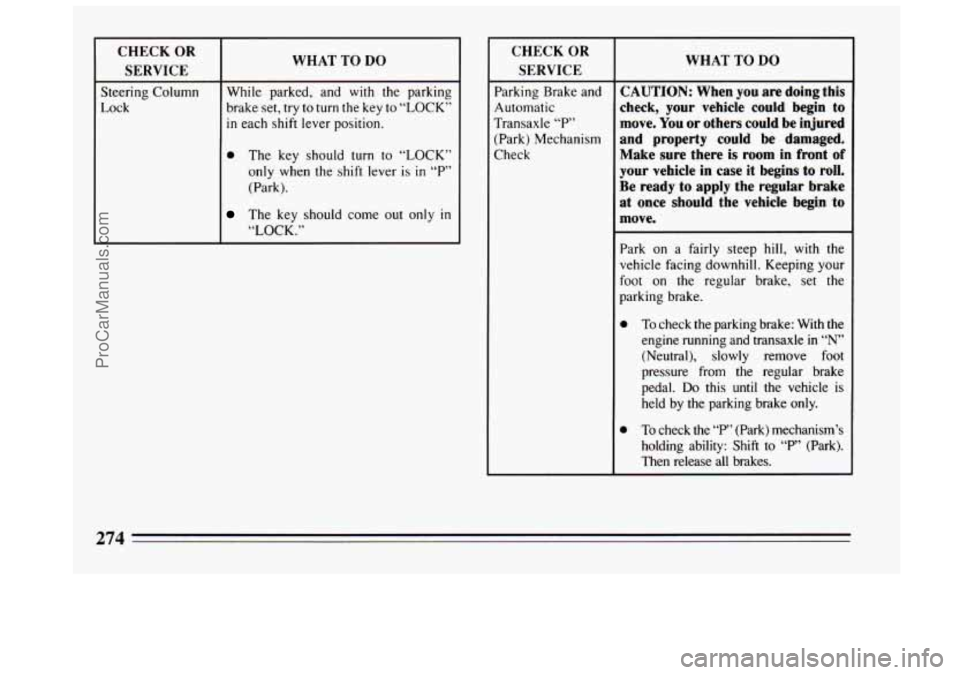
WHAT TO DO
Steering Column brake set,
try to turn the key to “LOCK”
Lock While parked,
and with the parking
in each shift lever position.
0 The key should turn to “LOCK”
only when the shift lever is
in “P’
(Park).
The key should come out only in
“LOCK.”
CHECK OR
SERVICE
Parking Brake and
Automatic
Transaxle
“P’
(Park) Mechanism
Check
WHAT TO DO
CAUTION: When you are doing this
check, your vehicle could begin to
move. You or others could be injure&
and property could be damaged.
Make sure there is room in front of
your vehide in case it begins to roll.
Be ready to apply the regular brake
at once should the vehicle begin to
move.
Park on a fairly steep hill, with the
vehicle facing downhill. Keeping your
foot on
the regular brake, set the
parking brake.
0 To check the parking brake: With the
engine running and transaxle
in “N”
(Neutral), slowly remove foot
pressure from the regular brake
pedal.
Do this until the vehicle is
held by the parking brake only.
0 To check the “P’ (Park) mechanism’s
holding ability:
Shift to “P” (Park).
Then release all brakes.
274
ProCarManuals.com
Page 278 of 308

CHECK OR SERVICE
Steering, Suspension and
Front-Wheel-
Drive Axle Boot
and Seal
Inspection
Exhaust System
Inspection
Throttle Linkage
Inspection
WHAT TO DO
Inspect the front and rear suspension and
steering system
for damaged, loose or
missing parts, signs of wear, or lack of
lubrication. Inspect the power steering
lines and hoses for proper hookup,
binding, leaks, cracks, chafing, etc.
Clean and
then inspect the drive axle
boot seals
for damage, tears or leakage.
Replace seals if necessary.
Inspect the complete exhaust system.
Inspect the body near the exhaust
system. Look for broken, damaged,
missing or out-of-position parts as
well
as open seams, holes, loose connections,
or other conditions which could cause a
heat build-up
in the floor pan or could let
exhaust fumes into the vehicle. See
“Engine Exhaust”
in the Index.
Inspect the throttle linkage for
interference
or binding, and for
damaged
or missing parts. Replace
parts as needed.
CHECK OR
SERVICE
Brake System
Inspection
WHAT TO DO
Inspect the complete system. Inspect
brake lines and hoses for proper
hookup, binding, leaks, cracks,
chafing, etc. Inspect disc brake pads for
wear and rotors for surface condition.
Also inspect drum bmke linings for
wear and cracks. Inspect other brake
parts, including drums, wheel
cylinders, calipers, parking brake, etc.
Check parking brake adjustment.
You
may need to have your brakes inspected
more often if your driving habits or
conditions result
in frequent braking.
NOTE: A low brake fluid level can
indicate worn disc brake pads which
may need
to be serviced, Also, if the
brake system warning
light stays on or
comes on, something may be wrong
with the brake system. See “Brake
System Warning Light”
in the Index. If
your anti-lock brake system warning
light stays on, comes on
or flashes,
something may be wrong with
the
anti-lock brake system. See “Anti-Lock
Brake System Warning Light”
in the
Index.
276
ProCarManuals.com